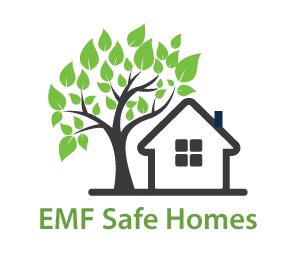
When you first start to EMF proof your home, you may discover that some pretty serious health issues disappear. That is what happened to me when I started to wire up my home and shield it from outside sources in 2016. I noticed that regular heart palpitations vanished as long as I was in my EMF safe home. When I went to my job as a school teacher, these very same heart palpitations reappeared. This was so consistent, that I soon realized where my heart palpitations were originating from.
At airports, when I would walk through the body scanner, it felt like my heart jumped out of my chest, so I subsequently asked for pat downs. Later, a relative who works in the industry told me that the pulsed frequency they use in these scanners is in the millimeter range and very powerful. You’re getting hit point blank. No wonder my body didn’t like it.
All these RF (radio frequencies) flying through the air do affect us. At work you can’t opt out like at an airport, so what do you do to stay safe at the workplace? You enact the Americans with Disabilities Act. I didn’t know this at the time because doctors are not trained to deal with microwave sickness and the media avoids talking about the health affects of wireless radiation.
In any case, the following is a somewhat lengthy and historic description of mine and other people’s journey through confusion and anxiety to the peace of mind of workplace accommodations. If you read nothing else, just remember this. When seeking accommodations, the first thing out of your mouth should be I need to speak with your American’s with Disabilities coordinator. I have been told these seem to be the magic words. If you say you have electro hypersensitivity, EHS, they will look at you as if you just said you have some sort of rare tropical disease. You need the ADA coordinator to speak the language of accommodations.
In this post, I’m going to give you some pointers and information that I found out about the ADA along the way as I treaded through the muddy waters of getting accommodated for a little understood disability.
First, let’s start from scratch. You have a situation at work that is intolerable: the wifi access points, the dirty electricity, whatever it is. You go to your immediate supervisor and tell that person the situation. If that person knows how to respond by communicating with his or her upper supervisor, they will tell you to go to the doctor and get a note from your physician stating your condition and they will put that on file.
If everyone is agreeable, you will iron out what your accommodations need to be. Example accommodations (get them if writing if you can) the ability to move to a different location if your work station is directly under a wifi access point, the ability to wear shielded clothing, the abitiy to hardwire your computer, the ability to install shielding material around your cubical or wall adjacent to a powerful source, the ability to turn off a source when not in use, the ability to work from a portable building away form wireless sources, the ability to shield a source, the ability to work from a hardwired connection from home. You get the idea. You will be the one bearing the burden of cost. But, like a friend of mine always says, it’s cheaper than a ride to the hospital.
The above scenario is good and achievable. If this scenario is not working out, you may want to educate them with a link to the Access Board website (the implementation agency of the ADA) Here The Access Board website can be very confusing and weird, so I did a bit of inquiring and found this link to the page describing accommodations. Here is a quote from that page:
“According to the Americans with Disabilities Act (ADA) and other disability laws, public and commercial buildings are required to provide reasonable accommodations for those disabled by chemical and/or electromagnetic sensitivities. These accommodations are best achieved on a case-by-case basis. Reasonable accommodations for a chemically sensitive and/or electromagnetically sensitive individual can include…”
It goes on to list a few example accommodations. If you have trouble getting the link to work, here are the clicks I took to get to the article from the Access Board home page: Advancing Access–Research–Completed Research–Building Elements and Space
If that is not enough to convince them to help you, I was told by a technician at the Access Board to refer them to the Equal Employment Opportunity Commission which is the arm of the Department of Justice that deals with the employer. If you go strait to the Department of Justice, not only will it be difficult to get a hold of anyone from the phone number on their webpage, they will just refer you to the EEOC in any case.
Stage 1 What do I do?
Back in 2016 not knowing about the Americans with Disabilities Act, I searched the internet for information. I found a school teacher on You Tube, Anura Lawson, from Los Angeles Unified School District. Take a look at her testimony at a Los Angeles School District Board Meeting. By the way, 2014, the year she testified to the board, was around the same time the schools had bought the concept of putting multiple wireless access points in all the classrooms in order to facilitate the new vision of “21st Century Learning.” Another phrase for it was “one to one” or putting a laptop in front of every student all day long. It was at this point I realized I must contact her because the same thing was beginning in my school, 2016, and I was seeing the same things happen to our students: bloody noses, headaches, unexplained tummy pain. The weirdest one was super runny noses where the snot was just cascading out of their noses. I was experiencing heart rhythm issues. Not only myself, but in the two years following the installations of the WAPs in every classroom, five teachers came down with heart related issues. Three were taken to the emergency room from campus, another was put under surgery to fix her heart issue, and myself who was cured simply by eliminating the wifi from my classroom using the ADA. I was able to email Aruna, and she was so kind to give me many resources, including information regarding the ADA for the electro hypersensitive. In 2016, LAUSD was accepting public input on an EHS accommodation policy which I was a part of. I haven’t been able to locate it on their massive website, but here is a general reasonable accommodations bulletin.
Stage 2: Does Everyone Know About This?
It was about this time that I realized there was a serious problem with wireless radiation, and the schools were definitely going down the wrong road. Little did I realize the powerful machinations behind this movement, and the inertia of the body politic to change course. As an optimistic citizen trying to warn the public, I gave testimony at a school board meeting in Elk Grove California: Board Meeting in Elk Grove which was being confronted with this same issue. Above is the link to that testimony. My two minutes start at 54:18 minutes into it.

Stage 3: Protect Yourself
So, after 2016, I’m still optimistic though disappointed after seeing hearings, boards, and even our District Union Leader turn a blind eye to this biological fact: wireless radiation harms people. Now, I’m just trying to protect myself, so I went to my principal and asked for certain things to accommodate myself according to the ADA. He was very receptive and helpful. The district told him to have me produce a doctor’s letter verifying this condition. That was challenging since almost 100 percent of doctors do not have a clue about microwave sickness and some do, very much, have unsubstantiated biases against believing it’s real.
The doctor’s visit was interesting. I had to say electro hypersensitivity twice in order for my doctor to hear it. He did not know what it was, so in the patient room, he went online while I guided him to the World Health Organization website describing it. There was a protocol on this website, though I found there are other better diagnostic protocols from friendlier sites such as WEEP initiative that educate doctors better. The WHO protocol started out with first giving tests to rule out other causes for the symptom. For my symptom, heart palpitations, I was given blood tests, and an Electro Cardiogram. None of the results indicated there was anything wrong with me. By the way, in my health care group’s data base, there was only one other person in the system who had been diagnosed with EHS. That is really sad because at least 3 percent of the population has it, so these three percent are suffering needlessly and unknowingly.
What they gave me was a paltry, watered down letter to give to my district that basically said I’m complaining of these symptoms and would they please accommodate me by taking out the WAP in my classroom. I have never been given a diagnosis of EHS, I’m assuming, because the doctors I have had do not have the training and experience to give a diagnosis in confidence. Still, the district accepted that letter. You are most likely not going to get a diagnosis, but all my doctors have given me requests to authority to allow me something or other. A letter to the jury committee to not be put in harms way by sitting in a room full of cell phones while waiting for the judge. A letter to the utility to ask for help with a particular bank of smart meters. So, the letter you get from your doctor may not be a big stick to use in protecting yourself, but it most likely will be enough. You are not going to get an official ADA card or handicap license plates. You do have a disability, but it does not require special parking. Can you get disability payments? Yes, but it probably won’t be very much, and you will have to get in line behind everyone else in the Social Security system. I already spoke with Social Security, and that is what they told me.
Stage 4 Empowered and Productive
Around the Fall of 2016, I had just started to figure out what to do to stay safe on campus. I knew what to stay away from, and I educated my colleagues. Everyone was really glad that they did not have EHS, so it was just me who was being affected. Yet, everyone now was experiencing crushing fatigue. At the end of the day, while I still had energy to do things after school, many teachers were dragging their way to their cars. Exhausted even at the beginning of the day. Thank goodness they were not being affected by it.
What I would do was wire up my computer. I was allowed to still teach with paper, very effectively, by the way. I was allowed to leave faculty meetings if I was getting symptoms. I asked my colleagues to put their phones on airplane mode. Many would, some would not do that. I could wear shielded clothing and locate WAPs in other rooms and seat myself as far away from them as possible. I greeted students at the door with my RF meter and if it lit up red, that student had to go to the end of the line and take care of his or her devices until the light was green when they approached the meter. It was wonderful. While other classes had cell phones ringing and problems with that sort of thing, my class was, for the most part, quiet because most students had their phones off. If one was on, I knew within minutes as my heart would tell me. Then I would be able to find the student with my meter and ask that they put it on the desk face up and off.
Be diplomatic about asking people to turn their phones on airplane mode or even off. Most people are obliging, but some get offended or feel put out. Always, always thank someone for helping you out and let them know you appreciate them helping you stay safe. They need to hear it because if you are asking again and again, they will get tired of it. They will get tired of being put out not realizing you live with this 24/7 and they are only being put out for a mere fraction of the day.
When interacting with employers, keep it brief, they are busy, and always express the same sentiments as above, thanks appreciation etc. You will need to pay for much of the accommodations. You will pay for shielding, ethernet cables, etc. I think that’s actually written in the ADA Access Board.
The Access Board, as I mentioned, is the entity that overseas the policy for ADA . It is a bit of a task to work the automated telephone system and speak to a real person, but it can be done with diligence, and the person I spoke with was very personable and informative. Lastly, as an added support, there is a Regional ADA Center for your part of the country. The Region 4 Southeast ADA Center covers Georgia, Alabama, and South Carolina. Their phone number is 404 541-9001.

